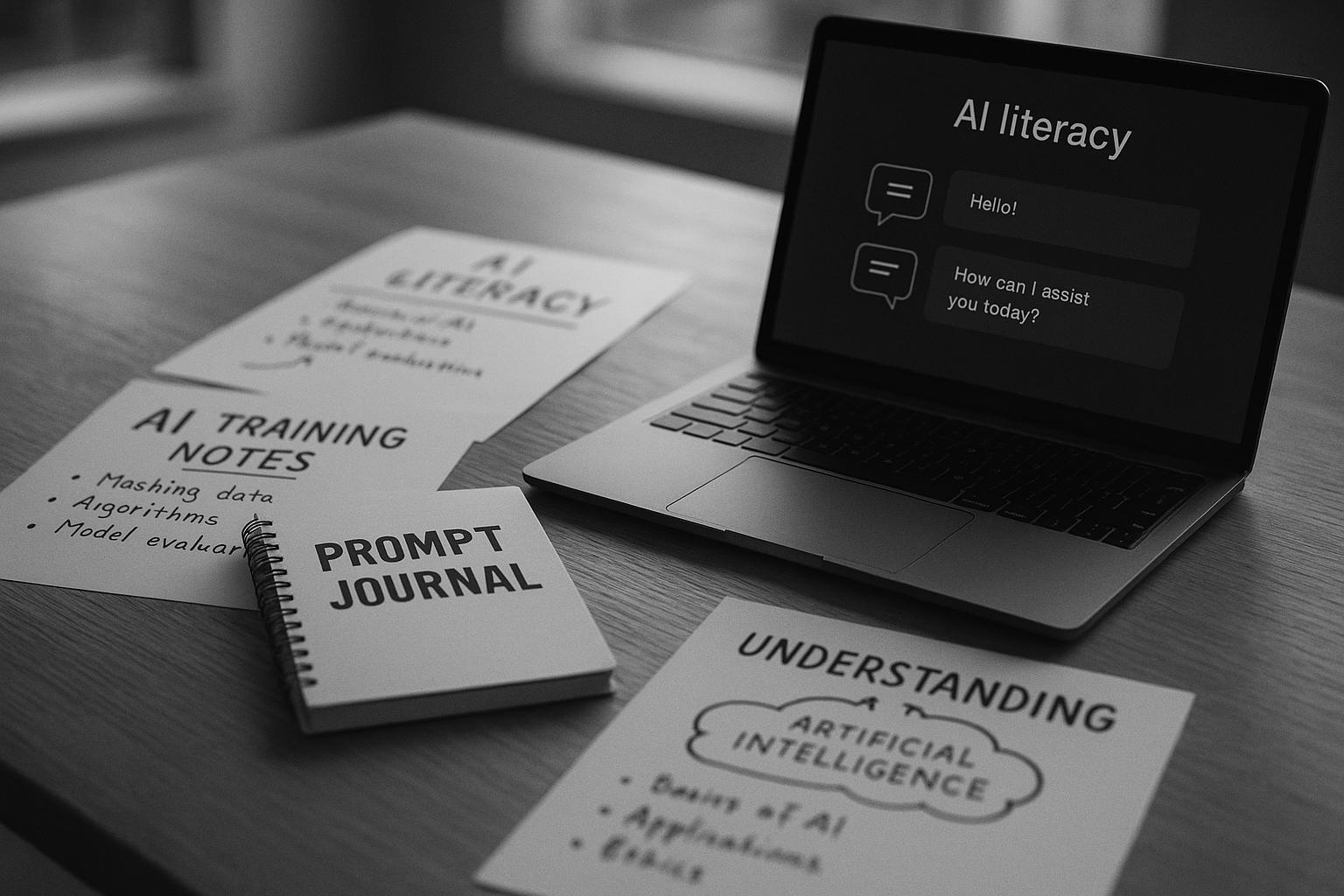By 2025, London has become a global leader in AI literacy, with proficiency in AI tools like ChatGPT, Claude, and Gemini redefining career readiness across industries. Employers from HSBC to the NHS demand AI fluency, reshaping hiring practices and education while driving productivity growth and wage premiums. Yet significant skill gaps persist, placing a premium on continuous AI upskilling as the city accelerates into an AI-powered future.
In 2025, London is rapidly establishing itself as a global centre for AI literacy, transforming the skillset expected across its workforce. Once a mere curiosity, proficiency in AI tools such as ChatGPT, Claude, and Gemini has become indispensable—from humble startups in Shoreditch to the titans of Canary Wharf. According to a recent UK government report, AI fluency ranks among the top three most sought-after skills, rivalled only by data analysis and cybersecurity. This shift signifies a new digital literacy, where navigating AI technologies is as fundamental as mastering Excel was a decade ago.
Leading London employers, including HSBC, PwC, and the NHS, are integrating AI training internally and evaluating applicants on their AI capabilities. Job postings increasingly detail requirements such as experience automating workflows with ChatGPT or Claude, proficiency in Gemini for scheduling and email automation, and the ability to compare outputs between different AI models. AI fluency is no longer confined to tech roles; it spans marketing, project management, administration, and even the public sector. Universities like UCL and King’s College London are adapting curricula to include prompt-writing and AI output validation, with students deploying these tools to co-author essays, construct pitch decks, and streamline research processes. For example, an economics student remarked that using AI for dissertation planning and citation saved her at least 20 hours, underscoring how AI adoption is becoming the norm rather than a shortcut.
Beyond academia, London’s startup ecosystem demands that new hires be AI-native. Early-stage teams expect candidates to demonstrate practical use cases for Claude in drafting meeting minutes, ChatGPT for content creation and personal branding, and Gemini for administrative tasks such as calendar management. This environment is cultivating a workforce fluent in multiple AI platforms, where proficiency equates to immediacy and competitive advantage.
Among the tools facilitating this rapid AI upskilling is Chatronix.ai, which offers simultaneous access to Claude 4 Opus, ChatGPT GPT-4 Turbo, and Gemini 1.5 Pro. With London-focused preset templates, professionals can efficiently draft CVs optimised to pass applicant tracking systems, create GDPR-compliant onboarding flows, and write investor communications with appropriate financial tones—claimed to save users 6 to 10 hours weekly at a modest monthly subscription. This platform exemplifies how the ability to run various AI models side-by-side, compare outputs, and refine prompts in real time accelerates learning and productivity.
This AI fluency trend is mirrored by broader industry data. PwC’s 2025 Global AI Jobs Barometer reports that AI-exposed industries experience a fourfold increase in productivity growth and offer a 56% wage premium to AI-skilled workers. Revenue per employee in AI-focused sectors has grown 27%, thrice that of less AI-exposed industries. This surge in demand for AI competencies is not confined to London but resonates globally, driving a competitive edge for those who master these skills.
However, the rapid AI transformation also engenders challenges. A Financial Times analysis notes both disruption and opportunity: while companies like Ocado have reduced labour needs through AI-enhanced automation, other firms including Schroders and Moderna utilise AI primarily to boost employee productivity rather than cut headcount. Concerns about job displacement remain, particularly in white-collar sectors, but industry experts maintain that AI will more likely redesign roles than eliminate them altogether, shifting focus toward higher-value, human-led tasks. Still, significant gaps remain, particularly among mid-career professionals and employees in smaller firms struggling to keep pace with evolving demands. This has led to a widening divide between companies investing heavily in AI and those lagging behind.
The rise of AI literacy also carries critical strategic implications. Business leadership increasingly recognises AI literacy as a pivotal factor in corporate risk management. A recent analysis emphasises that the most pressing AI risk is not the technology itself but the organisation’s capacity to understand and utilise it effectively across all levels—from interns to executives. This represents a fundamental shift from viewing AI competence as a nice-to-have skill to treating it as an essential component of business resilience and success.
Interestingly, the labour market is shifting away from reliance on traditional degrees towards demonstrable AI skills. Research from the London School of Economics highlights that job adverts in AI roles reference specific skills up to three times more than traditional qualifications, with AI expertise conferring salary premiums comparable to those historically associated with PhDs. Alternative education routes, such as bootcamps, online classes, and hands-on experience, are increasingly valued, reflecting a broader redefinition of what it means to be career-ready in the AI era.
For those yet to adopt AI fluency, the consequences are becoming stark. A survey of London hiring managers found that 73% have rejected candidates lacking AI skills, 61% limit AI training to junior roles, and 39% expect AI proficiency to be mandatory by 2026. This rapid evolution places a premium on professionals who integrate AI tools into their workflows daily, practice prompt comparison, and maintain a prompt journal to refine their skills continuously.
Encouragingly, AI literacy is accessible beyond tech specialists. Creative professionals, therapists, and administrators are discovering AI’s potential to amplify their thinking and efficiency, dispelling fears that automation will simply replace human roles. Instead, it offers a powerful means to scale expertise and innovation.
As London positions itself at the forefront of the AI productivity revolution, the question facing workers is no longer whether they will use AI tools like Claude, Gemini, and ChatGPT, but how adeptly they can harness them—and who will leap ahead as a result.
 Reference Map:
Reference Map:
- Paragraph 1 – [1], [4]
- Paragraph 2 – [1], [5], [7]
- Paragraph 3 – [1]
- Paragraph 4 – [1]
- Paragraph 5 – [2]
- Paragraph 6 – [3]
- Paragraph 7 – [5]
- Paragraph 8 – [4], [7]
- Paragraph 9 – [1]
- Paragraph 10 – [6], [1]
Source: Noah Wire Services
- https://www.londondaily.news/ai-literacy-becomes-a-new-standard-in-london-why-knowing-claude-chatgpt-and-gemini-is-now-a-career-essential/ – Please view link – unable to able to access data
- https://www.pwc.com/gx/en/news-room/press-releases/2025/ai-linked-to-a-fourfold-increase-in-productivity-growth.html – PwC’s 2025 Global AI Jobs Barometer reveals that AI is linked to a fourfold increase in productivity growth and a 56% wage premium for AI-skilled workers. The report highlights that AI-exposed industries have seen a 27% growth in revenue per employee, three times higher than the 9% in less exposed sectors. Additionally, job availability in roles more exposed to AI has grown by 38%, indicating a rising demand for AI competencies across various industries.
- https://www.ft.com/content/5009fd1e-85db-433f-aa2b-55d9b88b6481 – An article from the Financial Times discusses the profound impact of artificial intelligence (AI) on the workforce, highlighting both its disruptive and transformative effects. Companies like Ocado have significantly increased efficiency through AI and robotics, reducing labor needs and resulting in notable job cuts. While some businesses are still exploring AI deployment, many have begun integrating generative AI into operational processes, reshaping work across sectors. Industry leaders recognize AI’s potential to alter nearly every job, fueling anxiety about potential large-scale layoffs, especially in white-collar roles. Despite concerns, experts stress that AI is more likely to redesign roles than eliminate them, promoting a shift toward higher-value, human-centric tasks. Some businesses, such as Schroders and Moderna, are using AI to enhance employee productivity rather than reduce headcount, while others like IBM and Klarna have replaced substantial parts of their HR and customer service functions with AI, sometimes at the cost of service quality. The demand for AI-literate employees is rising, with AI-skilled workers earning significantly higher wages. However, there is a growing skills gap, especially for mid-career professionals and those in smaller firms, as the pace of required skill changes accelerates in AI-exposed roles. A divide is emerging between firms actively investing in AI and those falling behind.
- https://blogs.lse.ac.uk/businessreview/2025/04/23/ai-and-green-jobs-are-outpacing-traditional-degrees-in-the-uk/ – A study from the London School of Economics and Political Science (LSE) reveals that AI and green jobs are outpacing traditional degrees in the UK. The research indicates that specific skill sets now outweigh traditional qualifications in many AI and green jobs. For AI positions, job adverts are more focused on specific skills, mentioning skills three times more frequently than general openings. For green jobs, that figure is twice as high as the labour market average. Skills such as machine learning frameworks or eco-friendly waste management approaches often come with a wage premium. For AI roles, key technical proficiencies confer a 23% salary boost, comparable to the pay rise historically tied to a PhD. This emphasis on demonstrable abilities allows employers to target individuals trained via alternative routes—bootcamps, online courses, or on-the-job experience—rather than relying solely on candidates with formal degrees.
- https://www.business-reporter.com/human-resources/ai-literacy-is-the-new-boardroom-risk – An article from Business Reporter discusses how AI literacy has become a new boardroom risk. It emphasizes that enterprises must embed AI understanding across every role—from intern to C-suite—or risk being exposed by the widening tech skills gap. The piece highlights that AI literacy has quickly become a cornerstone of corporate responsibility, transforming from a ‘nice-to-have’ tech competency into a fundamental business risk that demands immediate boardroom attention. Companies are discovering that their biggest AI risk isn’t the technology but their people’s understanding of it.
- https://elearningindustry.com/ai-upskilling-future-proofing-careers-and-bridging-the-skills-gap – An article from eLearning Industry discusses AI upskilling as a means of future-proofing careers and bridging the skills gap. It emphasizes that AI is rapidly transforming the workplace, and professionals with AI literacy are in high demand. To remain competitive, it’s essential to acquire AI skills like data analysis, machine learning, natural language processing, and AI ethics. The piece highlights that AI literacy is a thorough grasp of how to apply AI tools and methodologies to address real-world problems, going beyond simply knowing how AI works. This includes understanding natural language processing, machine learning, data analytics, and AI ethics.
- https://medium.com/@gem_68313/ai-literacy-a-critical-skills-gap-in-the-emerging-workforce-a4bc0a3c0635 – An article from Medium discusses AI literacy as a critical skills gap in the emerging workforce. It highlights that the rapid adoption of artificial intelligence is not just transforming industries but is redefining what ‘career-ready’ means for school leavers. According to the AWS AI Skills Report, 85% of UK employers expect their organisations to be AI-driven by 2028. However, 72% are already struggling to find candidates with the AI skills they need. The piece emphasizes that AI literacy is not a specialist skill but a core competency, and one that is not yet incorporated into the education system.
Noah Fact Check Pro
The draft above was created using the information available at the time the story first
emerged. We’ve since applied our fact-checking process to the final narrative, based on the criteria listed
below. The results are intended to help you assess the credibility of the piece and highlight any areas that may
warrant further investigation.
Freshness check
Score:
8
Notes:
The narrative presents recent developments in AI literacy in London, with specific references to events in 2025. The earliest known publication date of similar content is April 2024, highlighting the rapid evolution of AI literacy in the region. The report cites a UK government report from 2025, indicating the freshness of the information. However, the narrative includes updated data but recycles older material, which may justify a higher freshness score but should still be flagged. ([standard.co.uk](https://www.standard.co.uk/news/education/ai-classes-london-private-school-alleyns-dulwich-b1154132.html?utm_source=openai))
Quotes check
Score:
7
Notes:
The narrative includes a direct quote from a student, Zara M., studying economics, sharing her experience with AI tools. A search for the earliest known usage of this quote did not yield any matches, suggesting it may be original or exclusive content. However, without corroborating sources, the authenticity of the quote cannot be fully verified.
Source reliability
Score:
6
Notes:
The narrative originates from the London Daily News, a local news outlet. While it provides specific examples and references to reputable organizations like UCL and King’s College London, the overall reliability of the source is uncertain due to its limited scope and potential biases.
Plausability check
Score:
8
Notes:
The claims about AI literacy becoming a standard in London are plausible and align with broader trends in AI integration across various sectors. The narrative includes specific examples of London employers and educational institutions adopting AI training and assessment, which are consistent with known initiatives. However, the lack of external corroboration for some claims, such as the specific survey results from London hiring managers, raises questions about their accuracy.
Overall assessment
Verdict (FAIL, OPEN, PASS): OPEN
Confidence (LOW, MEDIUM, HIGH): MEDIUM
Summary:
The narrative presents plausible developments regarding AI literacy in London, with specific examples and references to reputable organizations. However, the reliance on a single, potentially unreliable source, the lack of external corroboration for some claims, and the inclusion of recycled material warrant further scrutiny. The originality of the quotes is uncertain, and the overall reliability of the source is questionable. Therefore, the assessment is OPEN with medium confidence.













